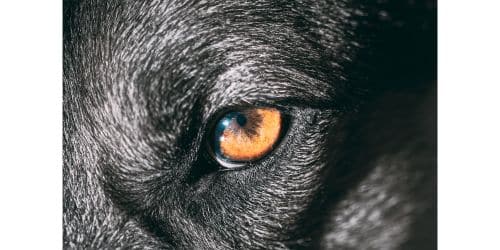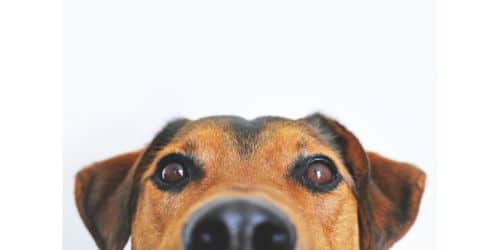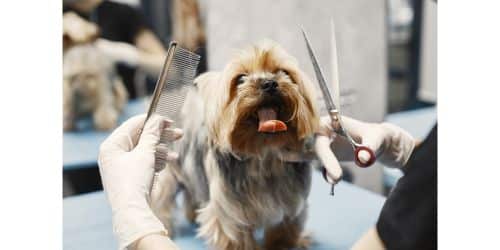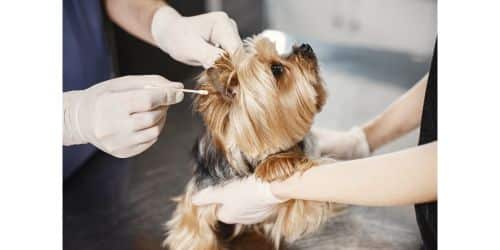Welcome to our in-depth look at dilated pupils in dogs. While a dog’s eyes are believed to be the windows to its soul, dilated pupils might be concerning at times. In this blog post, we will look at the many aspects of dilated pupils in dogs, such as the possible causes, related symptoms, and treatment choices. Understanding this disease can allow you to better care for your pet and assure their well-being.
The Basics of Dilated Pupils in Dogs
When you look into your dog’s eyes, you may notice that the size of their pupils varies. Dilated pupils, in particular, can draw your attention and raise concerns about your pet’s well-being. In this section, we will look at the basics of dilated pupils in dogs, including the role of pupils in vision, understanding the notion of pupil dilation, and learning how to spot these phenomena.
The Importance of Pupils in Vision
The eyes are wonderful organs that allow dogs to detect their surroundings. The pupil, a black circular opening in the center of each eye, regulates the amount of light entering the eye. Pupils play an important role in vision by altering their size to govern how much light reaches the retina at the back of the eye. This adjustment helps optimize vision in various lighting conditions, allowing dogs to see clearly both in bright sunlight and dim environments.
Understanding Pupil Dilation in Dogs
Pupil dilation is the enlargement or expansion of the pupil beyond its normal size. It happens when the muscles around the pupil, known as the iris, relax or contract in reaction to external stimuli. Dilated pupils can be caused by a variety of events, including normal physiological responses as well as underlying medical disorders. Understanding these elements may help you better grasp the importance of dilated pupils in your dog’s visual health.
How to Recognize Dilated Pupils in Dogs
Dilated pupils in your dog’s eyes require close inspection. Dilated pupils are distinguished by their increased size, which frequently manifests as a visible black circle that fills a major section of the iris.
Also, dilated pupils may cover a larger area than normal, making the colored component of the eye appear smaller. It’s vital to remember that pupil size varies naturally based on illumination and environmental factors. However, prolonged or excessive dilatation of your dog’s pupils may signal an underlying problem that requires additional research.
Normal Causes of Dog Pupil Dilation
While dilated pupils in dogs can be concerning at times, it is crucial to realize that this occurrence can have both normal and benign causes. In this section, we will look at the numerous factors that can cause pupil dilatation in dogs without indicating a medical problem. Understanding these common causes will help you avoid unneeded anxiety and guarantee your pet’s well-being.
#1. Environmental Considerations and Lighting Conditions:
One of the most common reasons for temporary pupil dilation in dogs is the response to changes in lighting conditions. When the surroundings become brighter, such as in direct sunshine or a well-lit room, the pupils dilate naturally to allow less light into the eye, preventing an overwhelming flow of light.
#2. Behavioral and Emotional Reactions:
Dogs, like humans, can have emotional and behavioral responses that cause their pupils to dilate. The release of adrenaline can be triggered by excitement, anticipation, or arousal which in turn causes pupil dilatation. This reaction is frequently witnessed during periods of play, engagement, or encountering something unique or exciting.
#3. Physiological Changes Associated with Exercise or Excitement:
Participating in physical activities or experiencing high levels of enthusiasm can also cause pupil dilation in dogs. During exercise, the body increases blood flow and oxygenation to match the increased demand, which might affect pupil size. Furthermore, endorphins and other neurotransmitters released during exercise or excitement can impact pupil dilation.
Read Also: The Best Plan B Options for Dogs
Medical Conditions Associated with Dilated Pupils in Dogs
While dilated pupils can be caused by benign reasons, it is critical to be aware of any underlying medical issues that may be connected with this phenomenon. This section will go through the numerous health concerns that might cause dilated pupils in dogs.
#1. Pain and Discomfort:
Pain or discomfort may be the cause of dilated pupils in dogs. When dogs experience acute or chronic pain, whether as a result of an injury, disease, or underlying condition, the body releases stress chemicals that can affect pupil size. Dilated pupils in conjunction with signs of distress, such as whining, restlessness, or behavioral abnormalities, may signal that your dog is in pain and requires emergency veterinarian assistance.
#2. Eye Injuries and Infections:
Eye injuries or conditions affecting the ocular tissues can cause dilated pupils in dogs. Pupil dilation can occur as a result of trauma, scrapes, foreign objects, or inflammation as the eyes respond to the damage or infection. Other symptoms may include redness, drainage, squinting, or vision abnormalities.
#3. Brain Trauma and Neurological Disorders:
Certain neurological conditions and brain trauma can cause dilated pupils in dogs. Head trauma, brain tumors, and neurological disorders can all disturb normal brain function and impair pupillary response. In these circumstances, dilated pupils are frequently associated with additional neurological symptoms such as imbalance, seizures, changed behavior, or coordination problems.
Read Also: The Top 5 Best Dog Care Shock Collars
Recognizing Symptoms Associated with Dilated Pupils in Dogs
Dilated pupils in dogs can indicate a variety of underlying medical issues. In this section, we will look at the symptoms that may accompany dilated pupils, giving you a thorough grasp of the warning indications. You can gain insight into your dog’s overall health and make informed decisions about their treatment if you recognize these symptoms.
#1. Changes in Vision and Eye Movements:
When dilated pupils are present along with vision abnormalities or erratic eye movements, it may be a sign of an underlying eye issue. Squinting, excessive blinking, difficulty focusing, or an aversion to bright light are all symptoms that your dog may display. Furthermore, rapid or disorganized eye movements, known as nystagmus, may indicate a neurological condition that necessitates veterinarian attention.
#2. Behavioral and Neurological Signs:
Dilated pupils in conjunction with behavioral and neurological changes can be cause for concern. These symptoms may include agitation, restlessness, bewilderment, disorientation, pacing, or circling. Anomalies in behavior, such as abrupt hostility or fearfulness, might also be detected. These signs of discomfort, distress, or neurological abnormalities necessitate a comprehensive examination by a veterinarian.
#3. Other Concurrent Physical Symptoms:
Other physical symptoms that may accompany dilated pupils should be noted since they can provide important clues about the underlying reason. Lethargy, loss of appetite, vomiting, diarrhea, weakness, or difficulty walking are some of the symptoms. Abnormalities in respiration, such as rapid or laborious breathing, should also be observed. Identifying these concurrent symptoms can help your veterinarian accurately diagnose the underlying illness.
Read Also: Can Dogs Get Tired of Barking?
When to Seek Veterinary Attention for Dilated Pupils in Dogs
When faced with dilated pupils in your dog, it’s critical to determine when veterinarian care is required. In this section, we will detail the factors that should drive your decision-making process, assisting you in determining when expert treatment for your pet is necessary.
#1. Persistent or Extreme Pupil Dilation:
If your dog’s pupils remain dilated for an extended period or if the dilation is extremely severe, you should see a veterinarian. While brief and modest pupil dilation is acceptable, sustained or considerable dilation may suggest an underlying medical problem that needs to be evaluated and treated.
#2. Concurrent Symptoms:
Other signs, in addition to dilated pupils, can cause worry. If your dog exhibits any other symptoms, such as changes in vision, odd eye movements, behavioral abnormalities, neurological disorders, or other physical symptoms, you must seek veterinarian care as soon as possible. These symptoms may signal a more serious health issue that necessitates a professional diagnosis.
#3. Injury or Trauma:
It is critical to seek emergency veterinarian care if your dog has suffered trauma, damage, or an accident involving the head or eyes. In such circumstances, dilated pupils may indicate serious injury or damage to the eyes or the neurological system.
#4. Sudden Onset or Worsening of Symptoms:
It is advisable to seek veterinarian assistance if your dog’s dilated pupils emerge suddenly or if symptoms increase suddenly. Rapid changes in pupil size without a clear explanation may signify an emergency that necessitates quick treatment by a veterinarian.
#5. Pre-existing Medical Conditions:
If your dog has a history of neurological abnormalities or pre-existing medical illnesses, any changes in pupil size should be discussed with your veterinarian. In these circumstances, dilated pupils may indicate a worsening of the present ailment or the onset of a new problem.
Diagnostic Procedures for Dilated Pupils in Dogs
Veterinary practitioners use a variety of diagnostic methods to establish the underlying reason for dilated pupils in dogs. In this section, we will look at the most common diagnostic procedures used to look into dilated pupils in dogs. Understanding these methods can assist you in understanding the steps involved in diagnosing and treating the disease.
#1. Physical Examination:
When examining a dog with dilated pupils, a comprehensive physical examination is sometimes the first step. The veterinarian will examine your dog’s overall health, look for any other symptoms, and ask about the start and length of the dilated pupils. They may also inquire about any recent injuries, toxic exposure, or behavioral or environmental changes.
#2. Ophthalmic Examination:
The eyes and their structures are the focus of an ophthalmic examination. The veterinarian will examine the health of the eyes, including the cornea, lens, retina, and optic nerve, with specialist instruments. This examination aids in the detection of any anomalies, injuries, infections, or underlying eye disorders that may be contributing to pupil dilation.
#3. Neurological Evaluation:
Because dilated pupils have been linked to neurological problems, a neurological evaluation may be performed. This evaluation entails watching your dog’s coordination, reflexes, locomotion, and demeanor. The veterinarian will look for evidence of neurological abnormalities, including weakness, tremors, imbalance, or changes in mental status, to lead additional diagnostic investigations.
#4. Diagnostic Testing:
Additional diagnostic tests may be indicated based on the results of the physical examination and ocular evaluation. Blood tests, imaging techniques (such as X-rays, ultrasound, or MRI), and specific eye tests (such as tonometry or electroretinography) are examples of these procedures. These methods aid in the identification of particular underlying causes, such as infections, injuries, tumors, or systemic disorders.
#5. Specialist Referral:
In some situations, your veterinarian may refer your dog to a veterinary ophthalmologist or a veterinary neurologist for additional testing and diagnostic treatments. These specialists have sophisticated training and equipment to analyze and diagnose difficult cases involving dilated pupils in more depth.
Treatment Options for Dilated Pupils in Dogs
The technique for treating dilated pupils in dogs is determined by the underlying cause of the problem. In this section, we will look at the many treatment options for dilated pupils and how to enhance your dog’s overall health. It is vital to note that a veterinarian should choose treatment based on a proper diagnosis.
#1. Addressing Underlying Medical Conditions:
Treating the underlying medical condition causing dilated pupils is critical for treating the problem. This could include particular interventions like:
- Eye Injuries or Infections: Medication, eye drops, or ointments may be used to treat infections, reduce inflammation, and aid recovery.
- Neurological Disorders: Treatment may include drugs, surgery, physical therapy, or other specialist therapies to address the underlying neurological disease, depending on the diagnosis.
- Pain Management: If dilated pupils are caused by pain, the veterinarian may give pain medications or suggest pain management measures to decrease discomfort.
#2. Supportive Care:
Supportive care is critical in improving your dog’s well-being while correcting dilated pupils. This could include:
- Environmental Changes: Creating a peaceful and comfortable environment can help reduce tension and anxiety in your dog, increasing overall comfort.
- Vision Support: In circumstances when dilated pupils impair vision, your veterinarian may advise you to take actions to support visual functions, such as providing appropriate lighting, wearing protective eyewear, or making environmental alterations to aid navigation.
- Emotional Support: Dilated pupils induced by emotional or behavioral responses may necessitate supporting interventions such as behavior modification approaches, environmental enrichment, or, in severe situations, consultation with a veterinary behaviorist.
#3. Surgical Interventions:
Surgical treatments may be required in some circumstances to address particular underlying reasons, such as eye injuries, tumors, or structural problems. Usually, veterinary professionals who are experts in their field perform surgical procedures.
#4. Ongoing Monitoring and Follow-up:
Following the start of treatment, your veterinarian will most likely propose regular monitoring to assess your dog’s response to therapy, examine the course of the underlying condition, and make any required changes to the treatment plan. Follow-up visits and discussions with your veterinarian are critical to ensure your dog’s best possible outcome.
Tips for Managing Dilated Pupils in Dogs at Home
When your dog has dilated pupils, giving them sufficient care and assistance at home can help them retain their comfort and well-being. In this part, we will provide some practical ideas and considerations to help you manage your dog’s dilated pupils while you await medical care or follow their treatment plan.
- Create a Calm Environment
- Minimize Stress and Anxiety
- Optimize Safety and Prevent Injury
- Maintain a Regular Feeding and Hydration Schedule
- Follow Medication and Treatment Plans
- Monitor Behavior and Symptoms
- Provide Emotional Support
Is it normal for my dog’s pupils to be dilated?
Dilated pupils in dogs can be caused by a variety of factors, and whether they are deemed normal or abnormal depending on the situation. Here are a few key items to consider:
- Lighting Conditions
- Excitement or Arousal
- Stress or Fear
- Medical Conditions
When should I be concerned about my dog’s dilated pupils?
You should be concerned about your dog’s dilated pupils in the following situations:
- Prolonged or Persistent Dilation
- Concurrent Symptoms
- Trauma or Injury
- Sudden Onset or Worsening
- Pre-existing Medical Conditions
In general, if you are unsure or concerned about your dog’s dilated pupils, you should seek the advice of a veterinarian. They can examine the problem, make an accurate diagnosis, and, if necessary, offer appropriate therapy.
How can I help my dog’s dilated pupils?
Helping your dog with dilated pupils depends on the underlying cause. However, here are some general tips that may provide support:
- Seek Veterinary Care
- Provide a Calm Environment
- Avoid Bright Lights
- Protect from Hazards
- Maintain a Regular Routine
- Offer Comfort and Reassurance
- Follow Veterinary Recommendation
Conclusion
Finally, dilated pupils in dogs might be a sign of a variety of underlying causes, ranging from normal responses to environmental factors to serious medical conditions. Recognizing the symptoms and obtaining veterinary care as soon as possible is critical for accurate diagnosis and treatment. Remember to keep your pet in a secure and loving environment, and always seek personalized advice from a veterinarian.
Related Articles
- Prostate Cancer in Dogs: Symptoms, Diagnosis, and Treatment Options
- Dog Shaking and Vomiting: Causes, Treatment, and When to Worry
- Dog Losing Weight: Causes, Solutions, and When to Act
- SIGNS OF FLEAS ON CATS: Early Signs, Causes, And Treatment
- TICK PARALYSIS IN DOGS: Causes, Symptoms, and Treatment






